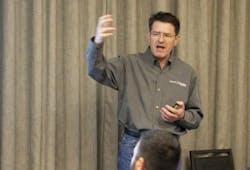Digital Twin Evolution: A 360-Degree View
When the digital twin was first conceived some 15 years ago, it was used as a research tool to mirror information. It’s been evolving ever since, becoming an increasingly useful and integral part of the manufacturing environment. It’s only been within the past few years that the digital twin has really started to interact with the value chain, being used to drive decisions—using localized sensors and edge computing to make a connection between the physical and virtual worlds.
Now and into the future, there are opportunities to make the digital twin more about the operator, combining technologies like artificial intelligence, machine learning and augmented reality to enable the connected operator. “Moving forward, we’re really starting to use it in operations and having the operator connected to the data,” said Tobias Scheele, senior vice president of software for Schneider Electric.
At the Innovation Summit: Software Conference 2017 this week in San Antonio, Texas, Schneider Electric executives have been putting emphasis on two key versions of the digital twin. The first is focused on the full end-to-end digital design, providing the ability to run predictive analytics against assets and close the digital loop across the asset’s lifecycle. It provides enterprise knowledge on everything from feedstock on through planning, scheduling, operations and distribution.
“It provides one reference point for the end-to-end digital value chain,” said Rob McGreevy, vice president of information, operations and asset management for Schneider Electric Software, during a morning keynote. “You don’t optimize one piece of it. You optimize the value chain.”
As the oil and gas industry focuses on four key areas of excellence—engineering, supply chain, operational and asset—the digital twin is an important piece of the asset excellence story: “The complete lifecycle from design to supply chain to somebody who needs to operate it to how to get the maximum out of it,” Scheele said in a breakout session yesterday.
In a breakout session today focused on the digital twin in oil and gas, Scheele expanded on these views of the digital twin, explaining how they would be used in a plant. He reiterated the concepts presented earlier in the day by McGreevy, starting with conceptual engineering—the first digital representation of the plant. The digital thread carries through the feed stage, detail engineering, procurement, and startup and commissioning. The digital twin also carries through to operations. “You want to make sure your operators know how to behave, and can push the plant to the maximum,” Scheele said. And then that leads into further optimization with the twin.
“It would be extremely powerful to have one digital representation of the entire value chain here,” Scheele said.
This whole description is the “first born” of the digital twins, so to speak. It’s used to simulate the entire plant before the assets are even designed. The other digital twin concept takes that even further with a 360-degree view of the digital asset:
- Process design: Processes, equipment and operations are analyzed through multiple simulations for optimal safety, reliability and profitability.
- Supply design: The digital twin of the supply chain takes into account the raw materials the assets are expected to handle. It provides valuable insights into the processing of raw materials into products.
- Operational data reconciliation: Variations from the optimal process and asset design are captured during run time, and the digital twin is updated with this information. This identifies gaps and anomalies, Scheele explained, to squeeze maximum performance out of assets.
- Virtual reality (VR)-based operations: Operations and maintenance personnel use augmented and virtual reality technologies with mobile devices to address plant and field-based maintenance issues for the involved assets. Thinking further into the future, Scheele said, there might not even be a need for a control room. For extremely harsh, dangerous or removed environments, for example, there could be just a VR representation of the environment.
- Artificial intelligence (AI): Using artificial intelligence, predictive learning technologies used with advanced process control, control strategy design and process optimization, the necessary variations from the process and asset design are fed back to the engineering stage of the lifecycle, enabling a complete and efficient digital value loop.
Schneider Electric’s 360-degree view of the asset takes the digital twin concept to the next level, Scheele said. “What do these new technologies allow on the operator’s part?” Scheele asked. “How do you make sure you get the maximum out of your assets?”
There are certain prerequisites to make sure a digital twin will work right for industry, Scheele said. It must be a unified modeling platform, scalable solution, open platform with easy connectivity, cloud-enabled and mobile device-enabled. But it also must be cool, he insisted. “This really goes more to the point of usability and capability,” he said. “There’s no time anymore these days, so you need to get quicker to the data. The whole point is to take out the complexity.”

